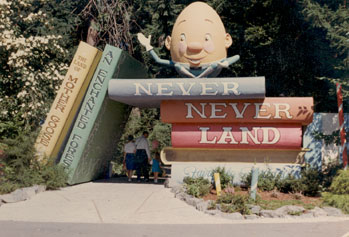(Pictured: Never Never Land, with its iconic figurine of Humpty Dumpty at the entrance, was once a children’s attraction at Point Defiance Park. Everything was removed after slipping into disrepair.)
TIME & AGAIN
From its origins in 1888 as a “loaner” from the U.S. military, Point Defiance Park is a place where Tacoma residents and visitors mingle with history, nature, and outdoor recreation.
The park’s mammoth size (756 acres) today encompasses a zoo, a boardwalk, a boathouse, a historic fort replica, a winding, scenic drive, and 400 acres of old-growth forest on a point of land jutting into Puget Sound. Now operated by Parks Tacoma (formerly Metro Parks), it was part of the homelands of the Puyallup Tribe, whose members still consider the space an important part of their tribal heritage.
The land began a new chapter 137 years ago when then-president Grover Cleveland signed legislation giving Tacoma the right to use it as a city park. Until then, it was an undeveloped military reservation. With no amenities, the public use of the park was limited to mostly seasonal camping on or near the shoreline now known as Owen Beach, which is named for Floyd Owen, a former park superintendent who was with the park district for 47 years..
In 1890, a streetcar line began carrying people to the park. By 1914, the Pagoda, an Asian-influenced building that still stands today, was serving as a streetcar station inside the park. The building had a heated waiting room for passengers, a first-aid-station, and marble-walled restrooms with attendants who handed out towels.
Here are some other early park milestones, and the years they occurred:
1903
Waterfront development of the park started, eventually producing a ferry dock, a restaurant, boat rentals, and refreshment stands.
1905
The federal government formally grants the title of Point Defiance Park to the city of Tacoma on March 3. The prime mover of the legislation was Congressman Francis W. Cushman, who was honored in 1925 for his efforts with a statue near the park.
1906
The Nereides Baths opened on Memorial Day. Tacoma’s first indoor swimming pool, or natatorium as it was then called, had Puget Sound saltwater heated to 80 degrees and rental bathing suits, all for 10 cents. The baths closed and the building was torn down in the early 1930s.
1921
Development of the park waterfront expanded with a major addition adjacent to the octagonal Pavilion. This arched concrete structure, also referred to as the Pavilion, eventually boasted three stories and included a restaurant, aquarium, and housing for park employees. Fire destroyed the boathouse and pavilion in 1984, but they were rebuilt and reopened four years later.
1933
Funland opened on Memorial Day. Privately operated, the amusement park provided an escape during the years of the Great Depression and World War II. Point Defiance Riding Academy also opened, giving horseback riders the opportunity to enjoy the park’s bridle paths. Both attractions closed in the 1960s.
1940s
Miltary influence at the point continued into this decade. The park, its forests, gardens, and attractions served the World War II homefront as a convenient and affordable local getaway during a time of gas rationing. Army Air Force crash boat rescue crews were stationed at the Pavilion during the war years in the event of a downed aircraft in Puget Sound.
1959
Point Defiance Zoo added the Children’s Farm Zoo, with cows, chickens, rabbits, ducks, and goats to delight city kids. Care of the farm animals was a cooperative venture between zoo staff and chapters of the Future Farmers of America. On a much larger scale, the zoo expanded after voters approved a bond issue in 1977.
